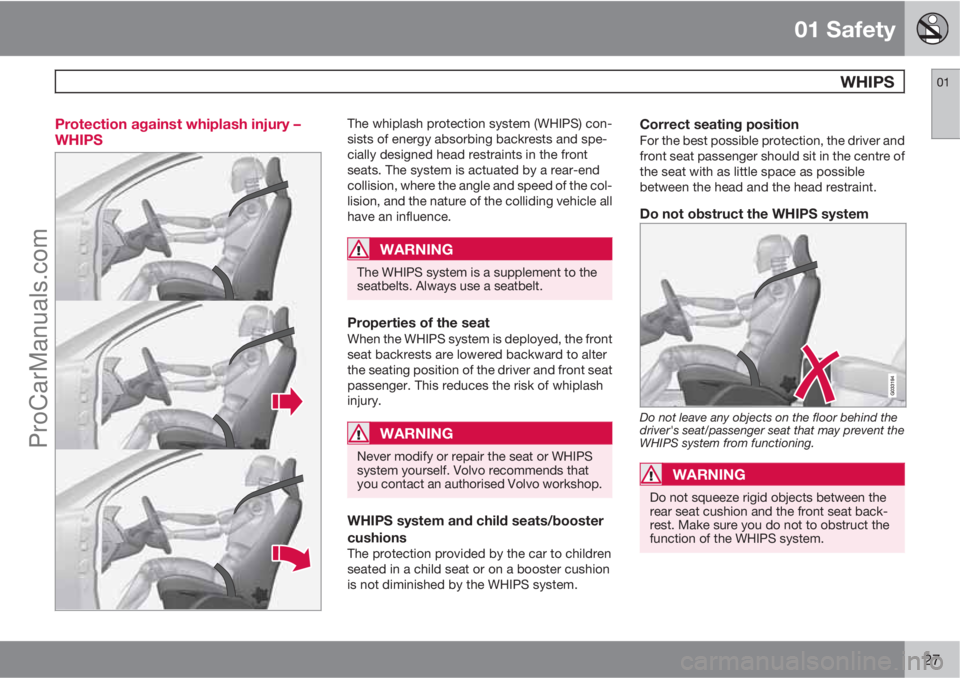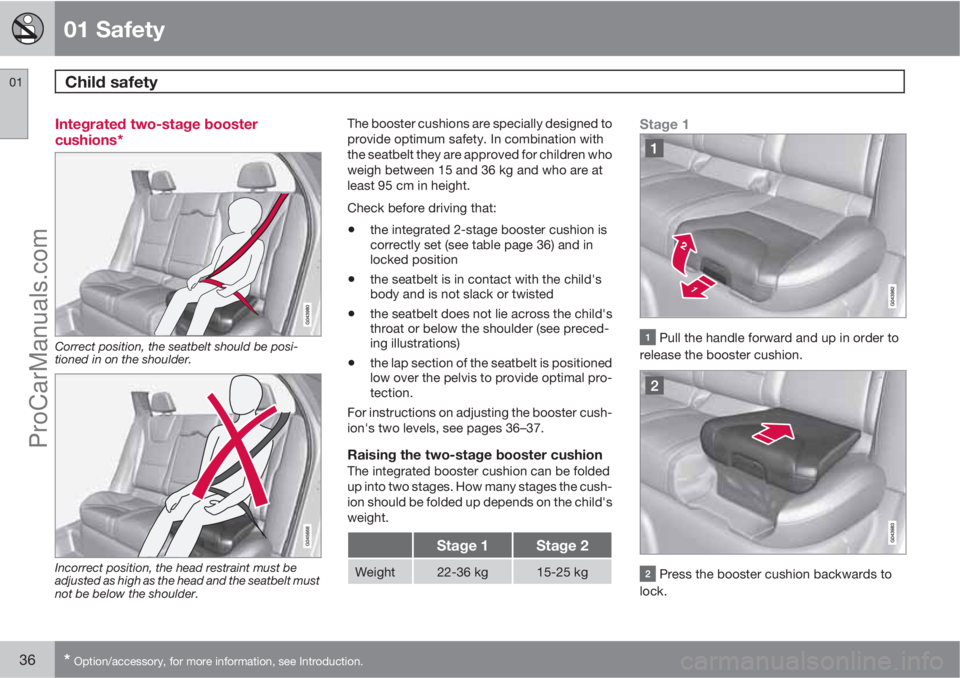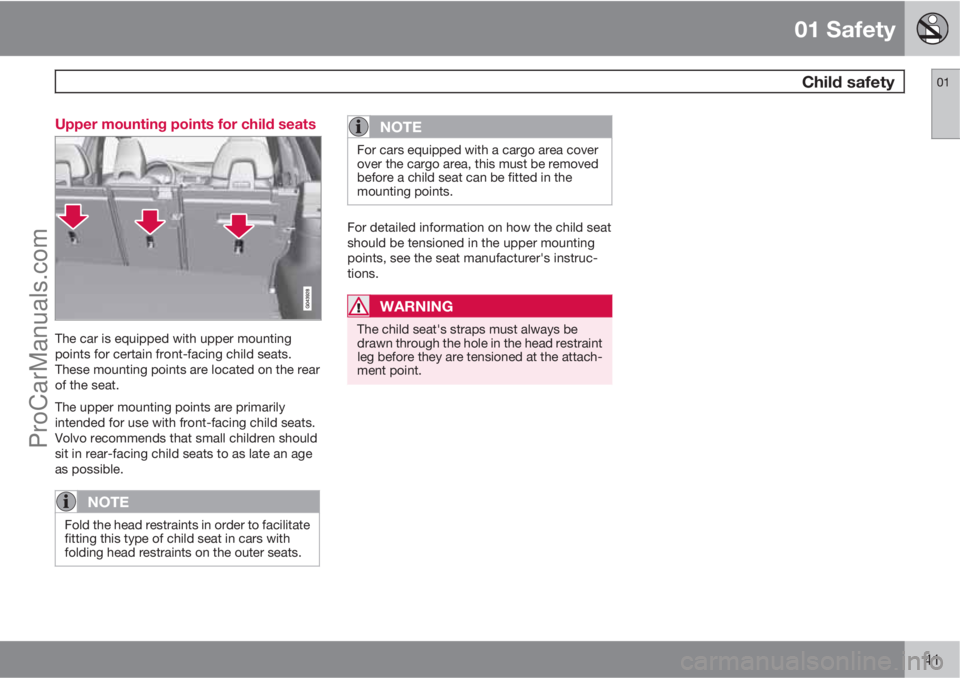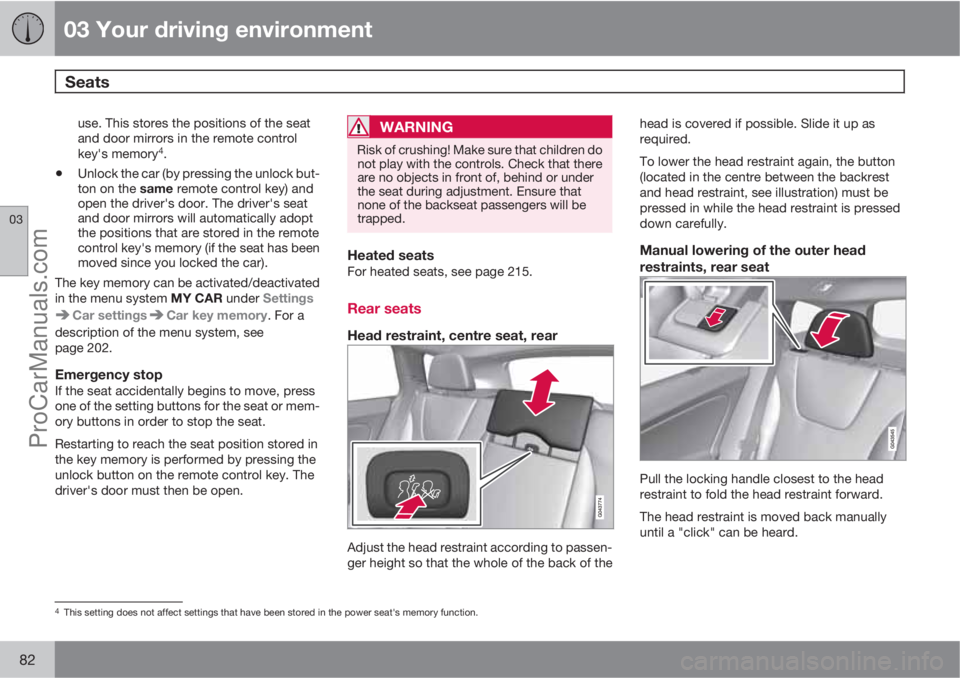2013 VOLVO V60 child restraint
[x] Cancel search: child restraintPage 20 of 422

01 Safety
Seatbelts 01
18
Seatbelt reminder
G017726
Unbelted occupants will be reminded to fasten
their seatbelts by means of an audio and visual
reminder. The audio reminder is speed
dependent, and in some cases time depend-
ent. The visual reminder is located in the roof
console and the combined instrument panel.
Child seats are not covered by the seatbelt
reminder system.
Rear seatThe seatbelt reminder in the rear seat has two
subfunctions:
•Provides information on which seatbelts
are being used in the rear seat. A message
appears in the information display when
the seatbelts are in use, or if one of the rear
doors has been opened. The message is
cleared automatically after driving for
approximately 30 seconds or after press-
ing the indicator stalk's OK button.
•Provides a warning if one of the rear seat-
belts is unfastened during travel. This
warning takes the form of a message on
the information display along with the
audio/visual signal. The warning stops
when the seatbelt is re-fastened, or it can
also be acknowledged manually by press-
ing the OK button.
The message on the information display show-
ing which seatbelts are in use is always avail-
able. Press the OK button to see stored mes-
sages.
Certain marketsAn acoustic signal and indicator lamp remind
the driver and front seat passenger to use a
seatbelt if either of them is not wearing one. At
low speed, the audio reminder will sound for
the first 6 seconds.
Seatbelt tensioner
All the seatbelts are equipped with belt ten-
sioners. A mechanism in the seatbelt tensioner
tightens the seatbelt in the event of a suffi-
ciently violent collision. The seatbelt then pro-
vides more effective restraint for the occu-
pants.
WARNING
Never insert the tongue of the passenger's
seatbelt into the buckle on the driver's side.
Always insert the tongue of the seatbelt into
the buckle on the correct side. Do not make
any damages on seatbelts nor insert any
foreign objects into a buckle. The seatbelts
and buckles would then possibly not func-
tion as intended in the event of a collision.
There is a risk of serous injury.
ProCarManuals.com
Page 29 of 422

01 Safety
WHIPS01
27 Protection against whiplash injury –
WHIPS
The whiplash protection system (WHIPS) con-
sists of energy absorbing backrests and spe-
cially designed head restraints in the front
seats. The system is actuated by a rear-end
collision, where the angle and speed of the col-
lision, and the nature of the colliding vehicle all
have an influence.
WARNING
The WHIPS system is a supplement to the
seatbelts. Always use a seatbelt.
Properties of the seatWhen the WHIPS system is deployed, the front
seat backrests are lowered backward to alter
the seating position of the driver and front seat
passenger. This reduces the risk of whiplash
injury.
WARNING
Never modify or repair the seat or WHIPS
system yourself. Volvo recommends that
you contact an authorised Volvo workshop.
WHIPS system and child seats/booster
cushions
The protection provided by the car to children
seated in a child seat or on a booster cushion
is not diminished by the WHIPS system.
Correct seating positionFor the best possible protection, the driver and
front seat passenger should sit in the centre of
the seat with as little space as possible
between the head and the head restraint.
Do not obstruct the WHIPS system
Do not leave any objects on the floor behind the
driver's seat/passenger seat that may prevent the
WHIPS system from functioning.
WARNING
Do not squeeze rigid objects between the
rear seat cushion and the front seat back-
rest. Make sure you do not to obstruct the
function of the WHIPS system.
ProCarManuals.com
Page 38 of 422

01 Safety
Child safety 01
36* Option/accessory, for more information, see Introduction.
Integrated two-stage booster
cushions*
Correct position, the seatbelt should be posi-
tioned in on the shoulder.
Incorrect position, the head restraint must be
adjusted as high as the head and the seatbelt must
not be below the shoulder.
The booster cushions are specially designed to
provide optimum safety. In combination with
the seatbelt they are approved for children who
weigh between 15 and 36 kg and who are at
least 95 cm in height.
Check before driving that:
•the integrated 2-stage booster cushion is
correctly set (see table page 36) and in
locked position
•the seatbelt is in contact with the child's
body and is not slack or twisted
•the seatbelt does not lie across the child's
throat or below the shoulder (see preced-
ing illustrations)
•the lap section of the seatbelt is positioned
low over the pelvis to provide optimal pro-
tection.
For instructions on adjusting the booster cush-
ion's two levels, see pages 36–37.
Raising the two-stage booster cushionThe integrated booster cushion can be folded
up into two stages. How many stages the cush-
ion should be folded up depends on the child's
weight.
Stage 1Stage 2
Weight22-36 kg15-25 kg
Stage 1
Pull the handle forward and up in order to
release the booster cushion.
Press the booster cushion backwards to
lock.
ProCarManuals.com
Page 43 of 422

01 Safety
Child safety01
41 Upper mounting points for child seats
The car is equipped with upper mounting
points for certain front-facing child seats.
These mounting points are located on the rear
of the seat.
The upper mounting points are primarily
intended for use with front-facing child seats.
Volvo recommends that small children should
sit in rear-facing child seats to as late an age
as possible.
NOTE
Fold the head restraints in order to facilitate
fitting this type of child seat in cars with
folding head restraints on the outer seats.
NOTE
For cars equipped with a cargo area cover
over the cargo area, this must be removed
before a child seat can be fitted in the
mounting points.
For detailed information on how the child seat
should be tensioned in the upper mounting
points, see the seat manufacturer's instruc-
tions.
WARNING
The child seat's straps must always be
drawn through the hole in the head restraint
leg before they are tensioned at the attach-
ment point.
ProCarManuals.com
Page 84 of 422

03 Your driving environment
Seats
03
82
use. This stores the positions of the seat
and door mirrors in the remote control
key's memory
4.
•Unlock the car (by pressing the unlock but-
ton on the same remote control key) and
open the driver's door. The driver's seat
and door mirrors will automatically adopt
the positions that are stored in the remote
control key's memory (if the seat has been
moved since you locked the car).
The key memory can be activated/deactivated
in the menu system MY CAR under Settings
Car settingsCar key memory. For a
description of the menu system, see
page 202.
Emergency stopIf the seat accidentally begins to move, press
one of the setting buttons for the seat or mem-
ory buttons in order to stop the seat.
Restarting to reach the seat position stored in
the key memory is performed by pressing the
unlock button on the remote control key. The
driver's door must then be open.
WARNING
Risk of crushing! Make sure that children do
not play with the controls. Check that there
are no objects in front of, behind or under
the seat during adjustment. Ensure that
none of the backseat passengers will be
trapped.
Heated seatsFor heated seats, see page 215.
Rear seats
Head restraint, centre seat, rear
Adjust the head restraint according to passen-
ger height so that the whole of the back of thehead is covered if possible. Slide it up as
required.
To lower the head restraint again, the button
(located in the centre between the backrest
and head restraint, see illustration) must be
pressed in while the head restraint is pressed
down carefully.
Manual lowering of the outer head
restraints, rear seat
Pull the locking handle closest to the head
restraint to fold the head restraint forward.
The head restraint is moved back manually
until a "click" can be heard.
4This setting does not affect settings that have been stored in the power seat's memory function.
ProCarManuals.com